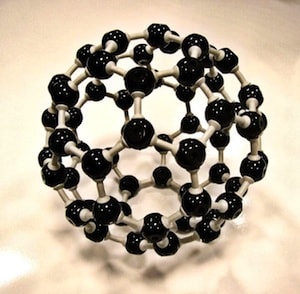
An important step as nanotechnology develops toward the ultimate goal of general purpose, high-throughput, atomically precise manufacturing is the use of molecules specifically designed to organize other molecules into precise orientations in space. Simple first steps would be to organize repeating lattices of one component to make novel functional materials; more complex further steps would be to precisely organize the multiple components of molecular machine systems. An early step in this process was reported this spring using a specially engineered protein. A hat tip to Nanowerk for reprinting this Dartmouth College news release “Researchers Create Artificial Protein to Control Assembly of Buckyballs“:
A Dartmouth College scientist and his collaborators have created an artificial protein that organizes new materials at the nanoscale.
“This is a proof-of-principle study demonstrating that proteins can be used as effective vehicles for organizing nano-materials by design,” says senior author Gevorg Grigoryan, an assistant professor of computer science at Dartmouth. “If we learn to do this more generally – the programmable self-assembly of precisely organized molecular building blocks — this will lead to a range of new materials towards a host of applications, from medicine to energy.”
The study appears in the journal in Nature Communications “Protein-directed self-assembly of a fullerene crystal” [OPEN ACCESS].
According to the U.S. National Nanotechnology Initiative, scientists and engineers are finding a wide variety of ways to deliberately make materials at the nanoscale – or the atomic and molecular level — to take advantage of their enhanced properties such as higher strength, lighter weight, increased control of light spectrum and greater chemical reactivity than their larger-scale counterparts.
Proteins are “smart” molecules, encoded by our genes, which organize and orchestrate essentially all molecular processes in our cells. The goal of the new study was to create an artificial protein that would self-organize into a new material — an atomically periodic lattice of buckminster fullerene molecules. Buckminster fullerene (buckyball for short) is a sphere-like molecule composed of 60 carbon atoms shaped like a soccer ball. Buckyballs have an array of unusual properties, which have excited scientists for several decades because of their potential applications. Buckyballs are currently used in nanotechnology due to their high heat resistance and electrical superconductivity, but the molecule is difficult to organize in desired ways, which hampers its use in the development of novel materials.
In their new research, Grigoryan and his colleagues show that their artificial protein does interact with buckyball and indeed does organize it into a lattice. Further, they determined the 3-dimensional structure of this lattice, which represents the first ever atomistic view of a protein/buckyball complex.
“Learning to engineer self-assembly would enable the precise organization of molecules by design to create matter with tailored properties,” Grigoryan says. “In this research, we demonstrate that proteins can direct the self-assembly of buckminsterfullerene into ordered superstructures. Further, excitingly, we have observed this protein/buckyball lattice conducts electricity, something that the protein-alone lattice does not do. Thus, we are beginning to see emergent material behaviors that can arise from combing the fascinating properties of buckyball and the abilities of proteins to organize matter at the atomic scale. Taken together, our findings suggest a new means of organizing fullerene molecules into a rich variety of lattices to generate new properties by design.”
The three high-resolution protein crystal structures presented here, respectively resolved to 0.167, 0.176, and 0.235 nm, reveal a protein lattice with C60 groups wedged between two helical protein segments. The authors suggest that binding of the protein motif to a C60 directs the organization of the protein units in the co-crystal. Perhaps a next step is to see if proteins can be designed to assemble C60 molecules into different lattice structures having different useful properties. It will be interesting to compare this approach using engineered proteins with approaches using DNA nanotechnology to organize nanoparticles into various crystal lattices.
—James Lewis, PhD
Discuss these news stories on Foresight’s Facebook page or on our Facebook group.
